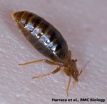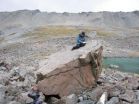(Press-News.org) In the latest issue of the journal Nature, Miguel Godinho Ferreira, Principal Investigator at the Instituto Gulbenkian de Ciência (IGC) in Portugal, lead a team of researchers to shed light on a paradox that has puzzled biologists since the discovery of telomeres, the protective tips of chromosomes: while broken chromosome ends generated by DNA damage (such as radiation or cigarette smoke) are quickly joined together, telomeres are never tied to each other, thus allowing for the correct segregation of the genetic material into all cells in our body. Since telomeres erode in response to the continuous cell divisions in our body, this protective function fades away as we grow older. Complete loss of telomeres results in sticky chromosome-ends that join to each other creating to genetic chaos – the very initial steps of cancer. Understanding how the tips of the chromosomes are protected from DNA repair and how the cells respond when they are unprotected will provide insights into the initial stages of tumourgenesis, ageing and future therapeutic interventions.
Cells respond to broken or damaged DNA by arresting their cell cycle while the damage is repaired. If the tips of chromosomes were recognized as broken DNA, cells would be constantly trying to mend the ends of chromosomes, leading to cell death and mutations in the DNA. Telomeres - the caps made up of protein and DNA at the tips of chromosomes - stop this from happening.
Through a series of meticulous experiments the Portuguese team, in collaboration with researchers at University of Illinois, Chicago, reveal that the crux lies in the changes of a protein, a Histone modification, located close to the telomeres. Histones are found along the entire length of all chromosomes, helping to package the DNA and also playing a role in regulating gene activity. Using fission yeast (used to make bread and beer) as a model organism, the researchers found that one of the Histones neighbouring the telomeres lacks a chemical signal, thus rendering the DNA damage recognition machinery incapable of arresting the cell cycle.
Says Miguel Godinho Ferreira, 'It's amazing, but it appears to be this single change that underlies the cell's ability to distinguish the end of the chromosome (i.e. a telomere) from a break in the middle. Indeed, along the rest of the genome, these Histones retain the chemical signal, so that when DNA damage does occur in any of these regions, DNA repair is set up and broken ends joined together.'
Telomeres are like the plastic caps on shoelaces: just as a shoelace starts unravelling when the cap is lost, so chromosome ends would become shorter with each cell division were it not for the telomeres. Telomeres are added or elongated by the enzyme telomerase. However, most cells in our body lack telomerase from when we are born, consequently telomeres become shorter and lose protection, sending signals for cells to stop dividing and start ageing. In about 85% of cancers, cells re-activate telomerase, contributing to their ability to divide and proliferate.
Even though DNA repair must be prevented at telomeres, assembly of the DNA damage recognition machinery is vital for telomerase activation and telomere elongation. Miguel Godinho Ferreira adds, 'Eukaryotic cells have evolved a very specific mechanism whereby telomerase recruitment goes ahead undisturbed, yet the whole DNA repair process is kept at bay from chromosome ends. Knowing the details of telomere capping is crucial to understanding its relationship to cancer, ageing and several diseases, and the multiple ways in which telomere manipulation may, potentially, lead to effective treatments".
He continues emphasizing the importance of fundamental basic research: "When Liz Blackburn, Carol Greider and Jack Szostak discovered telomerase and telomeres in the 80s, for which they got last year's Nobel Prize in Physiology or Medicine, they were searching for a solution to the "end-replication problem" and far from imagining the clinical implications these findings are currently developing. They were simply solving an academic puzzle created by the discovery of the double helix and the inability of DNA polymerases to synthesize the ends of linear DNA. Likewise, we are honored and excited to contribute to unravel these mechanisms, but perfectly aware that the direct implications of this work are still many years away".
INFORMATION:
(*) Tiago Carneiro1, Lyne Khair2, Clara C. Reis1, Vanessa Borges1, Bettina A. Moser2, Toru M. Nakamura2 & Miguel Godinho Ferreira1; 'Telomeres avoid end detection by severing the checkpoint signal transduction pathway'; Nature, volume 467, issue 7312, pp 228-232. DOI: 10.1038/nature09353
Why chromosomes never tie their shoelaces
New paper in Nature by Portuguese researchers provides light on paradox in cell biology world
2010-09-09
ELSE PRESS RELEASES FROM THIS DATE:
Anti-aphrodisiac protects young bedbugs
2010-09-09
Male bedbugs are known to be very unfussy when it comes to mating, mounting any well-fed bug they can see - regardless of age or gender. Researchers writing in the open access journal BMC Biology have discovered how immature bedbug nymphs, who would be harmed by the traumatic insemination technique practiced by the males, release alarm pheromones to deter this unwanted attention.
Vincent Harraca, from Lund University, Sweden, worked with a team of researchers to stage encounters between males and females or nymphs. He said, "The chemical communication, as well as the ...
Scots Pine shows its continental roots
2010-09-09
By studying similarities in the genes of Scots Pine trees, scientists have shown that the iconic pine forests of Highland Scotland still carry the traces of the ancestors that colonised Britain after the end of the last Ice Age, harbouring genetic variation that could help regenerate future populations, according to new results published in the journal Heredity.
The research was carried out by an international team from the Centre for Ecology & Hydrology, the Polish Academy of Sciences, the University of Edinburgh and the Macaulay Land Use Research Institute.
Today's ...
Study adds new clue to how last ice age ended
2010-09-09
As the last ice age was ending, about 13,000 years ago, a final blast of cold hit Europe, and for a thousand years or more, it felt like the ice age had returned. But oddly, despite bitter cold winters in the north, Antarctica was heating up. For the two decades since ice core records revealed that Europe was cooling at the same time Antarctica was warming over this thousand-year period, scientists have looked for an explanation.
A new study in Nature brings them a step closer by establishing that New Zealand was also warming, indicating that the deep freeze up north, ...
Investigating better endpoints for immunotherapy trials
2010-09-09
Cancer immunotherapy calls for revised clinical endpoints that differ from those used for chemotherapy, according to an article published online September 8 in The Journal of the National Cancer Institute.
Unlike chemotherapy, which acts directly on tumors, cancer immunotherapies exert their effects on the immune system, which may delay or change response patterns, perhaps owing to the dynamics of the immune system itself. For example, initial tumor burden may increase due to lymphocytic infiltration, because of T-cell proliferation, which is followed by lymphocyte-induced ...
Researchers identify potential new drug for neurodegenerative disease
2010-09-09
BOSTON, Mass. (September 8, 2010)‹Scientists have discovered a small
molecule that helps human cells get rid of the misfolded, disfigured
proteins implicated in Alzheimer¹s disease and other neurodegenerative
ailments. This potential drug could have applications for other conditions
as well.
Cells create and discard proteins continuously, a process that relies on a
balance between the speed with which new proteins are created and damaged
ones destroyed. Protein destruction occurs through a sophisticated system
that marks proteins for disposal by tagging them with ...
New study suggests changes in diagnosis and treatment of malaria
2010-09-09
LA JOLLA, CA - September 7, 2010 –A team of scientists from The Scripps Research Institute, the Genomics Institute of the Novartis Research Foundation (GNF), and the U. S. Naval Research Detachment in Peru has completed a study that could improve the efficacy of diagnosis and treatment strategies for drug-resistant malaria.
In the new study—published online on September 9, 2010 by the journal Genome Research—the scientists analyzed the genomic features of a population of malaria parasites in Peru, identifying the genetic basis for resistance to a common antibiotic.
Malaria ...
NIST researchers hear puzzling new physics from graphene quartet's quantum harmonies
2010-09-09
GAITHERSBURG, Md. – Using a one-of-a-kind instrument designed and built at the National Institute of Standards and Technology (NIST), an international team of researchers have "unveiled" a quartet of graphene's electron states and discovered that electrons in graphene can split up into an unexpected and tantalizing set of energy levels when exposed to extremely low temperatures and extremely high magnetic fields. Published in this week's issue of Nature,* the new research raises several intriguing questions about the fundamental physics of this exciting material and reveals ...
New sickle cell screening program for college athletes comes with serious pitfalls, experts say
2010-09-09
The Johns Hopkins Children's Center top pediatrician is urging a "rethink" of a new sickle cell screening program, calling it an enlightened but somewhat rushed step toward improving the health of young people who carry the sickle cell mutation.
Beginning this fall, all Division I college athletes will undergo mandatory screening for the sickle cell trait. The program, rolled out by the National Collegiate Athletic Association (NCAA), is an attempt to prevent rare but often-lethal complications triggered by intense exercise in those who carry the genetic mutation yet ...
Liver defect likely cause of DHA deficiency in Alzheimer's patients, UCI study finds
2010-09-09
Irvine, Calif. — UC Irvine researchers have discovered that markedly depleted amounts of an omega-3 fatty acid in brain tissue samples from Alzheimer's patients may be due to the liver's inability to produce the complex fat, also contained in fish-oil supplements.
Low levels of docosahexaenoic acid, or DHA, have been associated with the chronic neurodegenerative disease affecting millions of Americans, but no cause had been identified.
In postmortem liver tissue from Alzheimer's patients, the UCI team found a defect in the organ's ability to make DHA from shorter molecules ...
The Economics of Ecosystems and Biodiversity (TEEB) Local and Regional Policy Makers report launched at major biodiversity conference in Ghent
2010-09-09
Ghent, 9 September 2010 – Factoring the planet's multi-trillion dollar ecosystem services into policy-making can help save cities and regional authorities money while boosting the local economy, enhancing quality of life, securing livelihoods and generating employment.
This is the finding from a major international study, launched in a report by TEEB for Local and Regional Policy Makers, being released in Belgium, Brazil, India, Japan and South Africa.
In the Framework of the Belgian Presidency of the European Union, the Flemish Ministry of Environment, Nature and ...
LAST 30 PRESS RELEASES:
New expert guidance urges caution before surgery for patients with treatment-resistant constipation
Solar hydrogen can now be produced efficiently without the scarce metal platinum
Sleeping in on weekends may help boost teens’ mental health
Study: Teens use cellphones for an hour a day at school
After more than two years of war, Palestinian children are hungry, denied education and “like the living dead”
The untold story of life with Prader-Willi syndrome - according to the siblings who live it
How the parasite that ‘gave up sex’ found more hosts – and why its victory won’t last
When is it time to jump? The boiling frog problem of AI use in physics education
Twitter data reveals partisan divide in understanding why pollen season's getting worse
AI is quick but risky for updating old software
Revolutionizing biosecurity: new multi-omics framework to transform invasive species management
From ancient herb to modern medicine: new review unveils the multi-targeted healing potential of Borago officinalis
Building a global scientific community: Biological Diversity Journal announces dual recruitment of Editorial Board and Youth Editorial Board members
Microbes that break down antibiotics help protect ecosystems under drug pollution
Smart biochar that remembers pollutants offers a new way to clean water and recycle biomass
Rice genes matter more than domestication in shaping plant microbiomes
Ticking time bomb: Some farmers report as many as 70 tick encounters over a 6-month period
Turning garden and crop waste into plastics
Scientists discover ‘platypus galaxies’ in the early universe
Seeing thyroid cancer in a new light: when AI meets label-free imaging in the operating room
Neutrophil-to-lymphocyte ratio may aid risk stratification in depressive disorder
2026 Seismological Society of America Annual Meeting
AI-powered ECG analysis offers promising path for early detection of chronic obstructive pulmonary disease, says Mount Sinai researchers
GIMM uncovers flaws in lab-grown heart cells and paves the way for improved treatments
Cracking the evolutionary code of sleep
Medications could help the aging brain cope with surgery, memory impairment
Back pain linked to worse sleep years later in men over 65, according to study
CDC urges ‘shared decision-making’ on some childhood vaccines; many unclear about what that means
New research finds that an ‘equal treatment’ approach to economic opportunity advertising can backfire
Researchers create shape-shifting, self-navigating microparticles
[Press-News.org] Why chromosomes never tie their shoelacesNew paper in Nature by Portuguese researchers provides light on paradox in cell biology world




